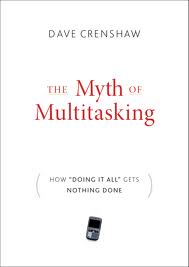Multitasking Made Easy – er
So I just finished teaching a 3-day workshop on Post-Rehab for Personal Trainers and currently have about a half-dozen textbooks, notebooks and workbooks in front of me as I’m preparing to head to Calgary next week to take a practical exam. Top this off with the fact that I have my regular clientele, a couple of webinars to start working on soon for Muscle Imbalances Revealed: Upper Body, as well as a wedding to plan, and you can begin to see how I’m tying to schedule my poops for the next few months to make sure I get them in.
I’ve never been a big fan of multi-tasking, primarily because it doesn’t work. I mean, if you have a lot of things to do, it can sometimes seem like you have to do them all at once or else you won’t get them done. The downside is that by switching your time and focus between multiple different things can make your life a living hell of half-done assignments, botched deadlines, pissed-off significant others, and pets with lonely forlorn looks as you’re not home to give them cuddles.
This isn’t just my opinion. Science has my back on this one. In a 2001 article published HERE, it was shown that when you try to do something new as well as something familiar (multitasking) your performance in completing both tasks goes down than if you were to try to complete each task on its own (sequential). What this means is that if you know what the hell you’re doing, you can do it on autopilot without even thinking about it, but if you’re doing something novel (like studying), you’re best to focus on it and make sure it gets done before starting something else.
So let’s say you’re like me and you take on a dozen different projects at once. How do I manage to get everything done? I try to work on only one new task at a time, while completing all my usual tasks (training clients, working out, inspiring new levels of bad-assery in lesser men), while only taking on one new task at a time. Now that teaching is over, I can ramp up studying to full-speed, and once the exam is over, I’m going to dive head-first into getting the webinars completed.
This has two benefits. One: I never have to worry about trying to split my focus and failing to give anything direct attention. I can prioritize my focus based on the deadlines I have in front of me and the relative importance each task has on my life. With a wedding in 6 weeks you’d better believe that’s a big priority, but passing the exam this weekend is somewhat more pressing.
Two: I never get bored. I tend to have some serious ADD if I get bored, and wind up either getting into trouble or spending countless hours checking out Facebook or seeing what’s trending on Youtube. By the way, if you haven’t seen it yet, this is by far the best thing that came out of the recent riots in Vancouver.
Okay, back on track now. If you want to get more done in your life, start by trying to do less. Work on accomplishing one thing, putting out one fire, or making sure one project gets completed before trying to start another one, especially if they have conflicting deadlines. Keep on time and make sure you have a strict “drop-dead” point where you can say it has to be done or else, then move on to the next feature. This can help to simply keep you focused and trying to get it done, rather than get it to 100%. A 90% effort that is finished and put away is better than a 100% effort that never gets completed.
I can remember one semester in university where my final exam schedule came out and I had five exams scheduled in 2 and a half days. The kicker was they were the first 2 and a half days of the final exam period, which meant my life involved copious amounts of coffee, Top Ramen noodles, intermittent sobbing and questionable hygiene for a few days while I was trying to cram my head-hole full of info on things like biochemistry, exercise physiology, calculus, organic chemistry, and advanced program design.
I would have been a complete mo-tard to try to study each of them at once, so I would set up time blocks of 2 hours each, and once one time block was over, I would eat, bang out some squats or get a quick jog, swear at the walls, and then get it on with the next subject. The downside was everything was happening at once. The upside was that each subject had a finite deadline, and that once it was done, there was no way in hell I was going to crack that book again. I could cross it off the list and move on with the rest of them.
To look more into making your life easier and not so complicated, try reading Dave Crenshaw’s very well-written book “The Myth of MultiTasking: How Doing it All Gets Nothing Done.” I read it over the summer in 2002, and it helped me to figure out a few aspects of how to put the wheels to the pavement and get things done and crossed off my proverbial to-do lists.


One Response to Multitasking Made Easy – er